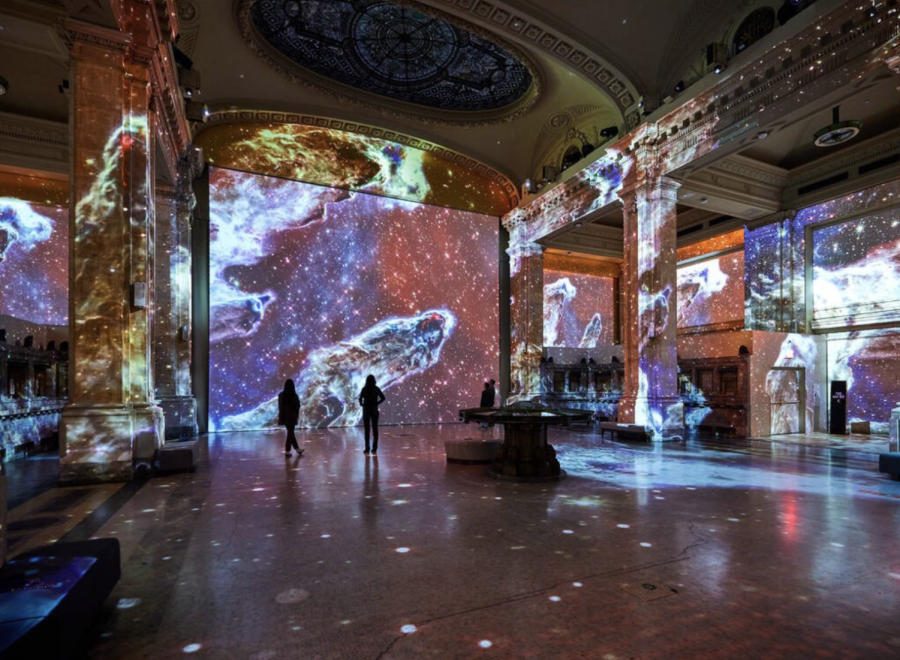“Destination Cosmos” at Hall des Lumières
Located in Lower Manhattan, Hall des Lumières is known for its “immersive art experiences,” which are intended to engage audiences through projections, soundtracks and light displays. Through June 4, Hall des Lumières is transforming its exhibition spaces into the vast expanse of space in its production of “Destination Cosmos: The Immersive Space Experience.” Created in collaboration with NASA and France’s CNES, the exhibition features footage from satellites, space missions and telescopes that are dynamically projected across the entire hall. The two-floor exhibition takes viewers on a virtual journey from Earth, through the solar system and beyond the Milky Way.
Entering the exhibit area, visitors have the option to view “Destination Cosmos” from the historical floor or the immersive floor. The historical floor, with its high ceiling and multiple pillars, is larger than the immersive floor and offers many different viewing areas. The immersive floor, though smaller, offers a truly remarkable experience as viewers will not miss any of the scenes or images with the room’s multiple mirror projections across the walls and floor.
Before completely transporting viewers into the realm of space, “Destination Cosmos” begins in the ancient world with the origins of space exploration and astronomical advancements. The hall becomes the night sky, and visitors are surrounded by numerous constellations that are traced simultaneously before their eyes. This is followed by images of pyramids and ancient telescopes representing the hallmarks of ancient achievement. Next, every inch of the exhibition room is covered in ’60s-style television sets that show footage of early space missions, including the Apollo 11 mission to the Moon.
After witnessing the assembly of modern equipment and machinery at the NASA Kennedy Space Center, viewers become a part of the launch of Artemis One, which marks the “Door to the Stars.” After the excitement, intensity and speed of takeoff, all becomes still and quiet as awe-inspiring satellite views of Earth appear across the hall. Such scenes serve as a reminder of just how remarkably wonderful Earth truly is. After exploring the International Space Station and the work of the astronauts onboard, the journey then takes visitors to the Sun, one of the most memorable and sensational parts of the experience. The hall becomes engulfed in solar flares on all sides, and viewers watch as the flares slowly spread across the hall’s floor. The exhibition then travels to the planets of the solar system. This part of the production highlights the various technologies and probes that contribute to the modern exploration of these planets. Particularly memorable, the projections on the floor create the effect of standing on the rings of Saturn and Jupiter.
The most beautiful and breathtaking part of the exhibition is its finale: the Milky Way. Images from probes and telescopes, such as the James Webb telescope, display the brilliant and vivid colors of the stars and the galaxy. The experience ends with footage of an astronaut traveling back to Earth with only the sound of her labored breaths. This scene is a powerful reminder of the perilous journey that astronauts and those in the field undertake in the exploration of space.
Though the footage and projections form the essence of the exhibition, the production would certainly be incomplete without its entrancing sounds. From Dvorak’s “New World Symphony” to David Bowie’s “Life on Mars,” “Destination Cosmos” masterfully combines music and soundtracks from all different genres and periods. The sound effects, ranging from heavenly sounds during views of the Milky Way and stars to thundering tracks for the solar flares, set the tone for each part and are characteristic of the exhibition’s immersive experience. Additionally, various technological and visual techniques enhance the experience and create a sense of constant motion. For example, the slow fading and zooming in and out of images create seamless transitions that have the effect of moving viewers further and further out into the universe.
Overall, “Destination Cosmos” truly lives up to its name in portraying a realistic and immersive journey through space. In addition to displaying the advancements and innovations in space exploration, the exhibition is a testament to modern technological achievements as a whole.











































































































































































































